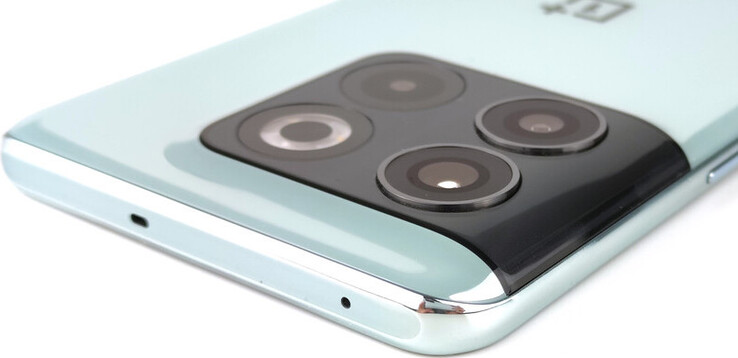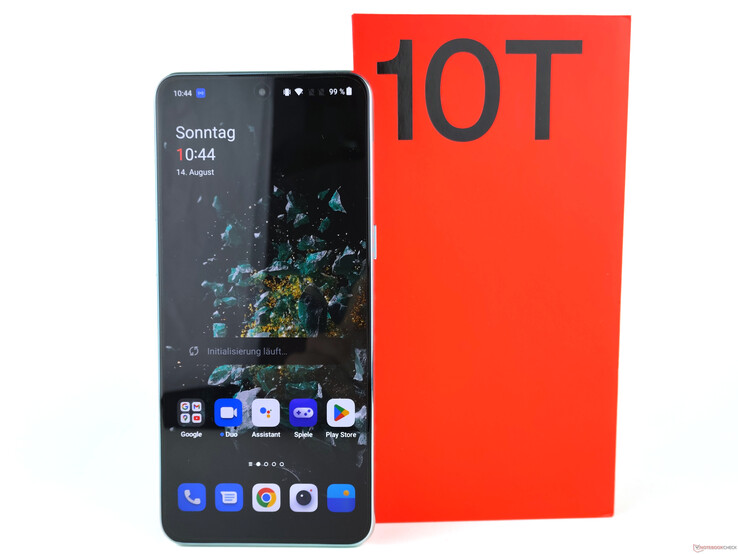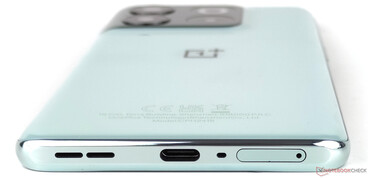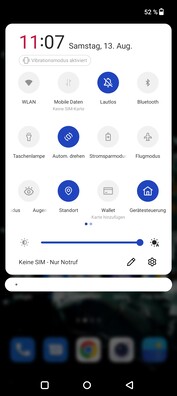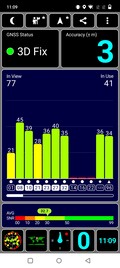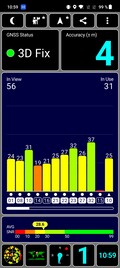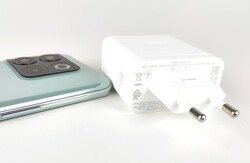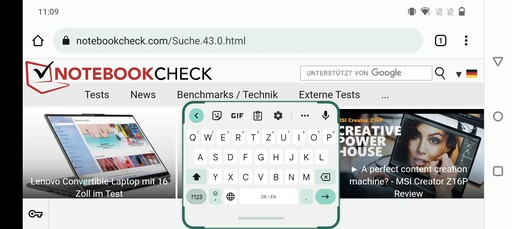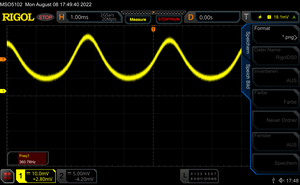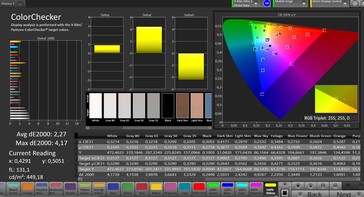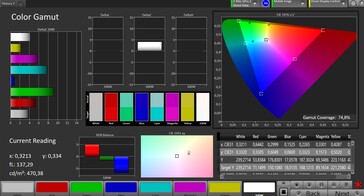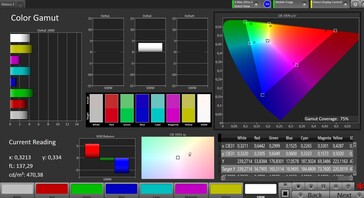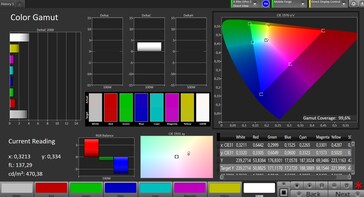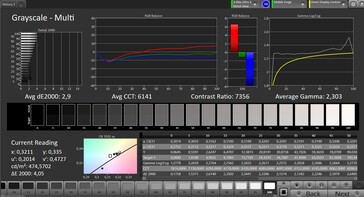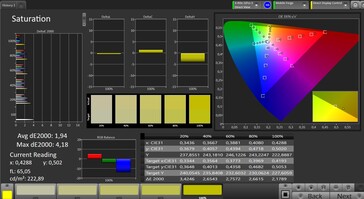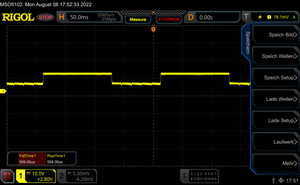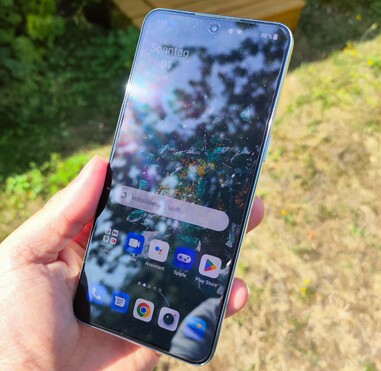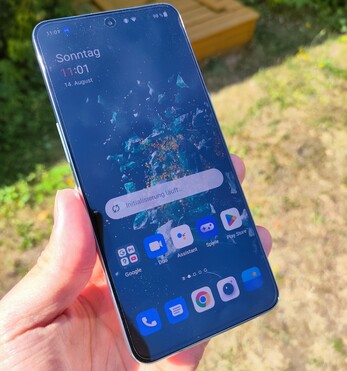OnePlus 10T smartphone review: The more efficient OnePlus 10 Pro thanks to Snapdragon 8+ Gen 1, accompanied by insanely fast charging
Although the OnePlus 10 never saw the light of day, the Chinese manufacturer is now bringing the T-model onto the market for the second half of the year. The OnePlus 10T deploys the Snapdragon 8+ Gen 1, which is supposed to be slightly faster and more power-efficient than the Snapdragon 8 Gen 1 in the OnePlus 10 Pro. Another highlight of the high-end smartphone is the inbuilt fast-charging technology: the 4,800 mAh battery can be charged with up to 150 watts via SUPERVOOC technology.
Compared to the Pro model, the camera system of the OnePlus 10T not only omits the Hasselblad branding, but also the telephoto camera, which has been replaced by a low-resolution macro camera. The basic model with 8 GB of RAM and 128 GB of storage is expected to be priced at around US$ 700, while the top version is equipped with a full 16 GB of RAM and 256 GB of storage. For this, OnePlus estimates that the RRP will be around US$ 800.
Possible Competitors in Comparison
Rating | Date | Model | Weight | Drive | Size | Resolution | Price |
|---|---|---|---|---|---|---|---|
| 87 % v7 (old) | 08 / 2022 | OnePlus 10T SD 8+ Gen 1, Adreno 730 | 203.5 g | 256 GB UFS 3.1 Flash | 6.70" | 2412x1080 | |
| 88.1 % v7 (old) | 06 / 2022 | OnePlus 10 Pro SD 8 Gen 1, Adreno 730 | 200.5 g | 256 GB UFS 3.1 Flash | 6.70" | 3216x1440 | |
| 87.7 % v7 (old) | 03 / 2022 | Xiaomi 12 SD 8 Gen 1, Adreno 730 | 179 g | 256 GB UFS 3.1 Flash | 6.28" | 2400x1080 | |
| 87.9 % v7 (old) | 04 / 2022 | Oppo Find X5 SD 888 5G, Adreno 660 | 196 g | 256 GB UFS 3.1 Flash | 6.55" | 2400x1080 | |
| 87.9 % v7 (old) | 03 / 2022 | Motorola Edge 30 Pro SD 8 Gen 1, Adreno 730 | 196 g | 256 GB UFS 3.1 Flash | 6.70" | 2400x1080 | |
| 89.3 % v7 (old) | 05 / 2022 | Samsung Galaxy S22 Exynos 2200, Xclipse 920 | 167 g | 128 GB UFS 3.1 Flash | 6.10" | 2340x1080 |
Case - OnePlus smartphone with punch hole
The OnePlus 10T has a flat OLED display on the front where the edges are nice and narrow. The ratio between the screen and the front of the device is a good 87.9%. In contrast to the OnePlus 10 Pro, which uses Gorilla Glass Victus, the T model only uses Gorilla Glass 5 on both sides.
The design of the OnePlus smartphone is strongly based on that of the sister models from Oppo. The glass back of the OnePlus 10T joins seamlessly with the main base, similar to a Find X5 Pro. Thanks to a special glass hot-bending process, there are virtually no transitions between the camera module and the back that can be felt with the fingers. The latter is available in two color versions, namely Jade Green and Moonstone Black. If you want to minimize fingerprints, you should not choose the high-gloss version, but the black version with its basalt-like texture.
We like the workmanship and the feel of the upper-class smartphone. Only the plastic frame does not really fit into the image of a US$ 700 smartphone. OnePlus justifies this with a novel antenna system consisting of a total of 15 individual antennas that is supposed to improve signal performance when held in landscape mode. This antenna system, which is arranged in a ring around the case, also requires considerably more space, so that the trademark of high-end OnePlus smartphones, the Alert Slider, has been sacrificed.
As with the OnePlus 10 Pro, the manufacturer has disposed of IP certification for its latest premium smartphone, so there is no official protection against dust, splash water or rain. Like the OnePlus 9, the 10T has the same sealing, according to OnePlus, so contact with water should (theoretically) not be a problem.
Features - OnePlus 10T with USB 2.0
The OnePlus 10T offers fast UFS 3.1 storage, which possesses a capacity of 256GB in our sample device. However, the actual available storage is significantly lower at 224GB due to the operating system and some preinstalled apps. Users who need more space for videos or photos will have to look for other alternatives because storage expansion via micoSD cards is not possible.
Unlike the Pro model, the USB-C port of the OnePLus 10T is only of the 2.0 specification, but external peripherals such as memory sticks can be connected via USB OTG. Wireless transmission of display content to external monitors via Miracast is also possible, and video content from streaming services can be viewed in HD quality thanks to Widevine L1.
Software - OnePlus smartphone with Android 12
The OnePlus 10T ships with Android 12, which will be combined with version 12 of the in-house Oxygen OS user interface at market launch. In the review period, the security patches were from July 2022 and prior to market launch. The manufacturer promises three major Android updates and four years of security patches after the initial release.
The update schedule foresees an upgrade to OxygenOS 13 with the new Aquamorphic design for the OnePlus 10 Pro later this year. Like the OnePlus 10 Pro, the user interface is based on a unified code base called Unified OS, which merges the operating systems of the Oppo and OnePlus smartphones. A special feature of the OnePlus 10T with its 16 GB of RAM is said to be the multitasking - the manufacturer claims that over 35 apps can run simultaneously in the background.
Communication & GNSS - OnePlus phone with WiFi 6
The OnePlus 10T is supposed to have a total of 15 antennas installed to ensure first-class 5G and Wi-Fi reception. As expected for smartphones in the price range of around US$ 700, the high-end smartphone uses Wi-Fi 6, but the 6 gigahertz frequency band cannot be used for WLAN transmissions.
In addition to the current Wi-Fi standard, the OnePlus 10T also offers multi-user MIMO, which ensures high and consistent transfer rates in the home network. In combination with Asus' ROG Rapture GT-AXE11000, we measured peak transmission rates of over 900 MBit/s.
The OnePlus phone supports all current mobile standards, including 5G for mobile internet access. The range of frequencies is very extensive and users are generally very well positioned. With a total of 24 supported LTE bands, nothing stands in the way of trips abroad with the OnePlus 10T.
| Networking | |
| iperf3 receive AXE11000 | |
| OnePlus 10T | |
| Samsung Galaxy S22 | |
| Average of class Smartphone (52 - 1721, n=177, last 2 years) | |
| iperf3 transmit AXE11000 | |
| OnePlus 10T | |
| Samsung Galaxy S22 | |
| Average of class Smartphone (49.8 - 1828, n=177, last 2 years) | |
In order to assess a smartphone's real-world localization capabilities, we record the test route with a Garmin Venu 2 for comparison purposes. The OnePlus phone determines its position with most satellite navigation systems that have at least dual-band connectivity.
Deviations are satisfactorily low overall, so that the recorded routes are often identical between the high-end smartphone and the Garmin smartwatch. Only minor inaccuracies are revealed in the GPS data, mostly in curves or turns.
Telephony & Voice Quality - OnePlus mobile phone with dual SIM
Cameras - OnePlus 10T with triple cam
The 16 MP front-facing camera hidden in the punch hole delivers good selfies with pleasing exposure levels and strong color reproduction. In portrait mode, the bokeh effects are spot on.
The OnePlus 10T does not depend on Sony's IMX789 like the 10 Pro, but uses the IMX766 sensor of the OnePlus Nord 2 5G's main camera. The 50 MP lens, stabilized with OIS, impresses with good image sharpness and vivid colors in bright light. However, OnePlus still has to make improvements regarding the exposure of bright image areas. The OnePlus 10T quickly reaches its limits in darkness. Especially in terms of light sensitivity and subject illumination, the 10 Pro operates on another level.
The same applies to the ultra-wide-angle lens, although a regression in terms of photo quality between the 10 Pro and the 2021 flagship was already visible here. The lens of the OnePlus 10T produce a 199 degree field view, some artifacts, relatively few details, and pronounced blurriness in the peripheral areas. The resolution of only 8 MP is also very low.
There are also cutbacks in video performance: an 8K option as well as UHD recording with the front cam or ultra-wide-angle camera are not available. The stabilization of the Sony IMX766 lens at 4K30 is decent and the recording quality is average. Changing lenses during recording is only possible at 1080p.
Image comparison
Choose a scene and navigate within the first image. One click changes the position on touchscreens. One click on the zoomed-in image opens the original in a new window. The first image shows the scaled photograph of the test device.
Main cameraMain cameraLow lightUltra wide angleOur color analysis with the ColorChecker Passport reveals relatively high deviations compared to the actual reference colors; the blue and green tones in particular don't really match. The colors are clearly brighter under controlled lighting conditions, but weaknesses are also visible in the gray tones, which could definitely be better for this price range.
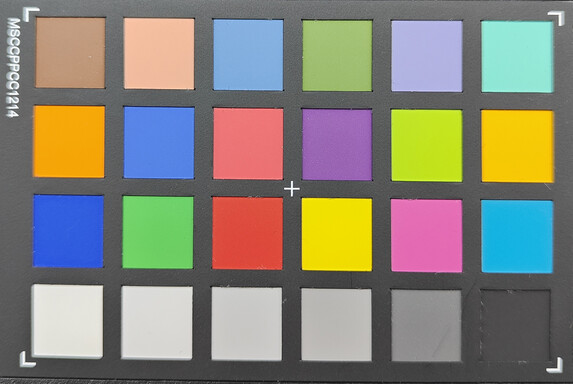
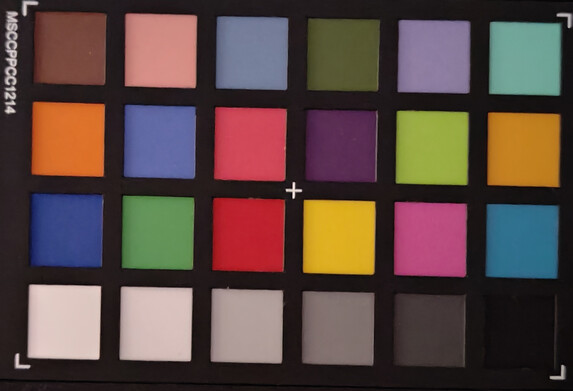
Accessories & Warranty - OnePlus phone with power adapter
The OnePlus 10T's scope of delivery includes a 160-watt power adapter, a red USB 2.0 cable (Type C to C), a SIM tool, and a quick-start guide. A protective cover is not included, but a protective film is installed ex works.
OnePlus offers a warranty of 24 months in Germany. This may differ from region to region, so be sure to check with your supplier before purchasing.
Input Devices & Operation - OnePlus 10T with 360 Hz
Those wanting to use face recognition to unlock the screen can do so via the front-facing camera. However, biometric identification with the face is not very secure due to the 2D process. The fingerprint sensor under the OLED screen should be used for reasons of security. Although this only works optically and not via ultrasonic technology, as in Samsung's Galaxy S22 Ultra, the sensor reacts quickly and usually recognizes the finger precisely.
The installed vibration motor provides nice haptic feedback in everyday use, but could be a little stronger for our taste. Good vibration qualities aside, operation of the smartphone is very smooth thanks to the high refresh rate of 120 Hz as well as the sampling rate of up to 360 Hz. The capacitive multi-touchscreen is even specified as having a touch-detection rate (via software) of up to 720 times per second in special applications (including games). A one-hand mode is also available, but has to be enabled in the settings first.
Display - OnePlus smartphone with OLED
The OnePlus phone uses a 6.7-inch AMOLED display with a refresh rate of up to 120 Hz. The resolution is 2412x1080, which results in a decent pixel density of about 400 PPI and a format of 20.1:9. Users can switch the refresh rate between 60 and 120 Hz. The OnePlus 10T does not have an LTPO display, like in the Pro model with adaptive control between 1 and 120 Hz. The panel offers HDR10+ certification and native support for 10-bit colors.
In terms of brightness, the AMOLED screen of the T model is on par with the flagship smartphone from OnePlus. Our measurements registered a maximum brightness of 873 cd/m² for the APL18, which is just as good at 861 cd/m² on a pure white background. However, a Xiaomi 12 or Galaxy S22 shine even brighter than the OnePlus 10T. The achieved luminance of less than 1000 cd/m² is also not optimal for HDR content.
The OnePlus 10T uses pulse width modulation (PWM) at a quite high frequency of 361 Hz for brightness control. We did not find a DC dimming mode in the settings menu, but the fluctuations in amplitude become much smaller at low brightness.
| |||||||||||||||||||||||||
Brightness Distribution: 97 %
Center on Battery: 861 cd/m²
Contrast: ∞:1 (Black: 0 cd/m²)
ΔE ColorChecker Calman: 2.27 | ∀{0.5-29.43 Ø4.78}
ΔE Greyscale Calman: 2.9 | ∀{0.09-98 Ø5}
99.6% sRGB (Calman 2D)
Gamma: 2.303
CCT: 6141 K
| OnePlus 10T Fluid AMOLED, 2412x1080, 6.7" | OnePlus 10 Pro AMOLED, 3216x1440, 6.7" | Xiaomi 12 OLED, 2400x1080, 6.3" | Oppo Find X5 AMOLED, 2400x1080, 6.6" | Motorola Edge 30 Pro AMOLED, 2400x1080, 6.7" | Samsung Galaxy S22 AMOLED, 2340x1080, 6.1" | |
|---|---|---|---|---|---|---|
| Screen | 26% | 10% | 17% | 16% | 12% | |
| Brightness middle (cd/m²) | 861 | 793 -8% | 867 1% | 709 -18% | 649 -25% | 853 -1% |
| Brightness (cd/m²) | 856 | 776 -9% | 867 1% | 718 -16% | 649 -24% | 858 0% |
| Brightness Distribution (%) | 97 | 95 -2% | 98 1% | 95 -2% | 98 1% | 96 -1% |
| Black Level * (cd/m²) | ||||||
| Colorchecker dE 2000 * | 2.27 | 0.79 65% | 1.7 25% | 1.3 43% | 1.18 48% | 1.9 16% |
| Colorchecker dE 2000 max. * | 4.17 | 1.93 54% | 4.4 -6% | 2.5 40% | 2.07 50% | 3.2 23% |
| Greyscale dE 2000 * | 2.9 | 1.3 55% | 1.8 38% | 1.3 55% | 1.5 48% | 1.9 34% |
| Gamma | 2.303 96% | 2.223 99% | 2.2 100% | 2.27 97% | 2.236 98% | 2.07 106% |
| CCT | 6141 106% | 6624 98% | 6762 96% | 6489 100% | 2538 256% | 6460 101% |
* ... smaller is better
Screen Flickering / PWM (Pulse-Width Modulation)
| Screen flickering / PWM detected | 360.8 Hz | ||
The display backlight flickers at 360.8 Hz (worst case, e.g., utilizing PWM) . The frequency of 360.8 Hz is relatively high, so most users sensitive to PWM should not notice any flickering. However, there are reports that some users are still sensitive to PWM at 500 Hz and above, so be aware. In comparison: 53 % of all tested devices do not use PWM to dim the display. If PWM was detected, an average of 8098 (minimum: 5 - maximum: 343500) Hz was measured. | |||
Series of measurements at a fixed zoom level and different brightness settings
The installed OLED display, in which individual pixels can be completely disabled, resulting in an "absolute" black, offers strong contrasts and good calibration. In our tests with the software CalMAN and a spectrophotometer, the panel of the OnePlus 10T delivers low color deviations (in the profile "natural") within the target range of <3. Furthermore, the upper-range phone offers many setting options which, in addition to different profiles, also affect individual parameters in Pro mode.
Display Response Times
| ↔ Response Time Black to White | ||
|---|---|---|
| 1.2 ms ... rise ↗ and fall ↘ combined | ↗ 0.6 ms rise | |
| ↘ 0.6 ms fall | ||
| The screen shows very fast response rates in our tests and should be very well suited for fast-paced gaming. In comparison, all tested devices range from 0.1 (minimum) to 240 (maximum) ms. » 5 % of all devices are better. This means that the measured response time is better than the average of all tested devices (20.2 ms). | ||
| ↔ Response Time 50% Grey to 80% Grey | ||
| 1.3 ms ... rise ↗ and fall ↘ combined | ↗ 0.7 ms rise | |
| ↘ 0.6 ms fall | ||
| The screen shows very fast response rates in our tests and should be very well suited for fast-paced gaming. In comparison, all tested devices range from 0.165 (minimum) to 636 (maximum) ms. » 5 % of all devices are better. This means that the measured response time is better than the average of all tested devices (31.6 ms). | ||
The OnePlus 10T is very well equipped for everyday outdoor use. In direct sunlight and the accompanying reflections on the glass surface, content is always sufficiently legible due to the high brightness and strong contrasts (photos with protective film).
The viewing angle stability of the AMOLED panel is also very good. Even at flat viewing angles, only a minimal loss of brightness is perceptible.
Performance - OnePlus 10T with Qualcomm SoC
As one of the first smartphones in Europe, the OnePlus 10T uses the Snapdragon 8+ Gen 1, hich not only promises up to 10 percent more CPU performance compared to the 10 Pro, but also 10 percent higher GPU clock rates.
But the savings potential is the main focus here: According to Qualcomm, power consumption drops by 15 percent compared with the Snapdragon 8 Gen 1, and performance per watt increases up to 30 percent.
We used high-performance mode for our benchmark measurements. Similar to Huawei devices, OnePlus has been throttling the performance capabilities of the Qualcomm chipset ex-factory since the OnePlus 9 Pro. The Snapdragon 8+ Gen 1 is roughly on par with the performance of a Snapdragon 8 Gen 1 in the single core of Geekbench 5, but the Plus version impresses with a score of almost 3000 points in the multi-core test.
| AImark - Score v2.x | |
| Oppo Find X5 | |
| OnePlus 10T | |
| Xiaomi 12 | |
| Samsung Galaxy S22 | |
| Average Qualcomm Snapdragon 8+ Gen 1 (1043 - 7865, n=11) | |
| OnePlus 10 Pro | |
Performance differences between the Snapdragon 8+ Gen 1 and its predecessor are slightly larger in the graphics benchmarks. In the offscreen scores of GFXBench, the OnePlus 10T with its Adreno 730 outperform the Snapdragon 8 Gen 1 equipped competition by 20% at times. Similar to the 10 Pro, the onscreen rates reveal the software-affinity with the company's brother Oppo. The Chinese lock their phone at 60 frames per second.
| 3DMark | |
| Wild Life Extreme Unlimited | |
| OnePlus 10T | |
| OnePlus 10 Pro | |
| Xiaomi 12 | |
| Samsung Galaxy S22 | |
| Motorola Edge 30 Pro | |
| Oppo Find X5 | |
| Wild Life Extreme | |
| OnePlus 10T | |
| OnePlus 10 Pro | |
| Xiaomi 12 | |
| Samsung Galaxy S22 | |
| Motorola Edge 30 Pro | |
| Oppo Find X5 | |
| Wild Life Unlimited Score | |
| OnePlus 10T | |
| OnePlus 10 Pro | |
| Xiaomi 12 | |
| Samsung Galaxy S22 | |
| Motorola Edge 30 Pro | |
| Oppo Find X5 | |
| GFXBench (DX / GLBenchmark) 2.7 | |
| T-Rex Onscreen | |
| Xiaomi 12 | |
| Samsung Galaxy S22 | |
| Motorola Edge 30 Pro | |
| OnePlus 10 Pro | |
| Oppo Find X5 | |
| OnePlus 10T | |
| 1920x1080 T-Rex Offscreen | |
| OnePlus 10T | |
| Xiaomi 12 | |
| OnePlus 10 Pro | |
| Motorola Edge 30 Pro | |
| Samsung Galaxy S22 | |
| Oppo Find X5 | |
| GFXBench 3.0 | |
| on screen Manhattan Onscreen OGL | |
| Xiaomi 12 | |
| Samsung Galaxy S22 | |
| Motorola Edge 30 Pro | |
| Oppo Find X5 | |
| OnePlus 10 Pro | |
| OnePlus 10T | |
| 1920x1080 1080p Manhattan Offscreen | |
| OnePlus 10T | |
| Xiaomi 12 | |
| OnePlus 10 Pro | |
| Samsung Galaxy S22 | |
| Oppo Find X5 | |
| Motorola Edge 30 Pro | |
| GFXBench 3.1 | |
| on screen Manhattan ES 3.1 Onscreen | |
| Xiaomi 12 | |
| Samsung Galaxy S22 | |
| Motorola Edge 30 Pro | |
| Oppo Find X5 | |
| OnePlus 10 Pro | |
| OnePlus 10T | |
| 1920x1080 Manhattan ES 3.1 Offscreen | |
| OnePlus 10T | |
| Xiaomi 12 | |
| OnePlus 10 Pro | |
| Oppo Find X5 | |
| Samsung Galaxy S22 | |
| Motorola Edge 30 Pro | |
| GFXBench | |
| on screen Car Chase Onscreen | |
| Xiaomi 12 | |
| Motorola Edge 30 Pro | |
| Samsung Galaxy S22 | |
| OnePlus 10 Pro | |
| Oppo Find X5 | |
| OnePlus 10T | |
| 1920x1080 Car Chase Offscreen | |
| OnePlus 10T | |
| Motorola Edge 30 Pro | |
| Xiaomi 12 | |
| Oppo Find X5 | |
| OnePlus 10 Pro | |
| Samsung Galaxy S22 | |
| on screen Aztec Ruins High Tier Onscreen | |
| Xiaomi 12 | |
| Motorola Edge 30 Pro | |
| OnePlus 10T | |
| OnePlus 10 Pro | |
| Samsung Galaxy S22 | |
| Oppo Find X5 | |
| 2560x1440 Aztec Ruins High Tier Offscreen | |
| OnePlus 10T | |
| OnePlus 10 Pro | |
| Motorola Edge 30 Pro | |
| Xiaomi 12 | |
| Samsung Galaxy S22 | |
| Oppo Find X5 | |
| on screen Aztec Ruins Normal Tier Onscreen | |
| Motorola Edge 30 Pro | |
| Xiaomi 12 | |
| Samsung Galaxy S22 | |
| OnePlus 10 Pro | |
| Oppo Find X5 | |
| OnePlus 10T | |
| 1920x1080 Aztec Ruins Normal Tier Offscreen | |
| OnePlus 10T | |
| OnePlus 10 Pro | |
| Motorola Edge 30 Pro | |
| Xiaomi 12 | |
| Oppo Find X5 | |
| Samsung Galaxy S22 | |
System speeds are first-rate in everyday use and ensure smooth operation in combination with 16 GB of RAM in our review sample. Browsing with the Chrome browser is also solid, even though the benchmarks are somewhat modest.
| Jetstream 2 - 2.0 Total Score | |
| Average of class Smartphone (23.8 - 387, n=149, last 2 years) | |
| Average Qualcomm Snapdragon 8+ Gen 1 (76.2 - 204, n=23) | |
| Oppo Find X5 (Chrome 99.0.4844.73) | |
| Motorola Edge 30 Pro (Chrome 99) | |
| Xiaomi 12 (Chrome 99.0.4844.58) | |
| OnePlus 10 Pro (Chrome100) | |
| Samsung Galaxy S22 (Chrome 100.0.4896.79) | |
| OnePlus 10T (Chrome 104) | |
| Speedometer 2.0 - Result 2.0 | |
| Average of class Smartphone (15.2 - 643, n=122, last 2 years) | |
| OnePlus 10 Pro (Chrome100) | |
| Motorola Edge 30 Pro (Chome 99) | |
| Oppo Find X5 (Chrome 99.0.4844.73) | |
| Average Qualcomm Snapdragon 8+ Gen 1 (69.1 - 196, n=18) | |
| Samsung Galaxy S22 (Chrome 100.0.4896.79) | |
| Xiaomi 12 (Chrome 99.0.4844.58) | |
| OnePlus 10T (Chrome 104) | |
| WebXPRT 3 - Overall | |
| OnePlus 10 Pro (Chrome100) | |
| Oppo Find X5 (Chrome 99.0.4844.73) | |
| Average of class Smartphone (38 - 380, n=31, last 2 years) | |
| Motorola Edge 30 Pro (Chrome 99) | |
| Average Qualcomm Snapdragon 8+ Gen 1 (106 - 224, n=14) | |
| Samsung Galaxy S22 (Chrome 100.0.4896.79) | |
| Xiaomi 12 (Chrome 99.0.4844.58) | |
| OnePlus 10T (Chrome 104) | |
| Octane V2 - Total Score | |
| Motorola Edge 30 Pro (Chrome 99) | |
| OnePlus 10 Pro (Chrome100) | |
| Average of class Smartphone (2228 - 121337, n=197, last 2 years) | |
| Oppo Find X5 (Chrome 99.0.4844.73) | |
| Average Qualcomm Snapdragon 8+ Gen 1 (17622 - 61536, n=24) | |
| OnePlus 10T (Chrome 104) | |
| Samsung Galaxy S22 (Chrome 100.0.4896.79) | |
| Xiaomi 12 (Chrome 99.0.4844.58) | |
| Mozilla Kraken 1.1 - Total | |
| OnePlus 10T (Chrome 104) | |
| Samsung Galaxy S22 (Chrome 100.0.4896.79) | |
| Average of class Smartphone (257 - 28190, n=154, last 2 years) | |
| Average Qualcomm Snapdragon 8+ Gen 1 (665 - 1707, n=22) | |
| Xiaomi 12 (Chrome 99.0.4844.58) | |
| Oppo Find X5 (Chrome 99.0.4844.73) | |
| OnePlus 10 Pro (Chrome100) | |
| Motorola Edge 30 Pro (Chrome 99) | |
* ... smaller is better
The loading times of applications are pleasantly short in the OnePlus 10T, which is also due to the fast write and read rates of the UFS 3.1 storage. However, the speed of the installed storage medium lags behind the competition.
| OnePlus 10T | OnePlus 10 Pro | Xiaomi 12 | Oppo Find X5 | Motorola Edge 30 Pro | Samsung Galaxy S22 | Average 256 GB UFS 3.1 Flash | Average of class Smartphone | |
|---|---|---|---|---|---|---|---|---|
| AndroBench 3-5 | 35% | 70% | 24% | 40% | 23% | 43% | 73% | |
| Sequential Read 256KB (MB/s) | 1568.37 | 1602.12 2% | 1851 18% | 1964 25% | 1832 17% | 1486 -5% | 1757 ? 12% | 2228 ? 42% |
| Sequential Write 256KB (MB/s) | 847.69 | 1253.34 48% | 1417 67% | 782 -8% | 1028 21% | 993 17% | 1204 ? 42% | 1852 ? 118% |
| Random Read 4KB (MB/s) | 173.45 | 284.34 64% | 325.2 87% | 272.9 57% | 277.7 60% | 273 57% | 287 ? 65% | 296 ? 71% |
| Random Write 4KB (MB/s) | 211.24 | 264.45 25% | 437.5 107% | 259.3 23% | 339.5 61% | 257.6 22% | 318 ? 51% | 339 ? 60% |
Gaming - OnePlus phone only manages 60 fps
In order to assess GPU performance in everyday use, we ran a few Android titles with the software of our GameBench tool. The manufacturer has implemented the PA Frame Stabilizer and GPU Load Control features especially for gamers, which should enable better system stability. However, only selected games support this so far, namely Genshin Impact and PUBG mobile.
Indeed, both Android games run without major frame drops. As for PUBG Mobile, the Chinese manufacturer sets a 60-fps limit , no matter which graphics setting we choose - with the exception of UHD mode. Here, the OnePlus 10T runs stably and without notable drops at 40 fps. The limit is 30 fps in Genshin Impact.
Even Armajet, which theoretically supports up to 144 FPS, only has a maximum of 60 fps. Even inexpensive mid-range SoCs, like the Snapdragon 695, manage over 80 fps on average in the 2D multiplayer shooter. Due to the high waste heat, the manufacturer seems to have played it safe with the OnePlus 10T because the case gets very warm during gaming.
Emissions - OnePlus 10T gets hot
Temperature
Although the OnePlus 10T has a new Cryo Velocity Vapor cooling system and a more efficient SoC in the Snapdragon 8+ Gen 1, we recorded a higher surface temperature (a maximum of 46.7 °C) than in the 10 Pro. Waste heat in normal mode also becomes a problem in the SoC's performance stability, because voltage- and overheating protection often kicked in during testing.
We checked for possible throttling of the chipset via a stress test of the GFX benchmark (OpenGL3.1), which repeated the respective test scenario thirty times in succession and logged the frame rates. Afterwards, the OnePlus phone was subjected to 3DMark stress tests.
A reduction in the frame rate under high load does not occur in GFX Bench, but the case gets very warm here as well and system crashes occur. The OnePlus 10T also regularly overheats in both 3DMark test scenarios.
After around 10 tests, only the Wild Life stress test is completed in a fully cooled case without much prior use. However, a reduction in performance is hardly noticeable here as well, so OnePlus chose a fairly aggressive set-up in terms of SoC management. Either the high waste heat leads to regular system crashes or the Snapdragon 8+ Gen 1 does its work almost unthrottled until the end of the respective usage scenario.
(-) The maximum temperature on the upper side is 46.7 °C / 116 F, compared to the average of 35.2 °C / 95 F, ranging from 21.9 to 247 °C for the class Smartphone.
(±) The bottom heats up to a maximum of 41.5 °C / 107 F, compared to the average of 34 °C / 93 F
(+) In idle usage, the average temperature for the upper side is 28.4 °C / 83 F, compared to the device average of 32.9 °C / 91 F.
3DMark Wild Life Stress Test
| 3DMark - Wild Life Stress Test Stability | |
| OnePlus 10T | |
| OnePlus 10 Pro | |
| Motorola Edge 30 Pro | |
| Samsung Galaxy S22 | |
| Oppo Find X5 | |
| Xiaomi 12 | |
Speakers
The dual speakers of the OnePlus 10T are not as loud or linear as those of the 10 Pro. Overall, the two speakers lack depth, and bass is absent. The mids and highs could also be much better for a high-end phone.
Headphones or external speakers can be connected via the USB-C port. Those who prefer Bluetooth for wireless output have access to audio codecs such as SBC, AAC, aptX, aptXHD and aptX adaptive as well as LDAC and LHDC.
OnePlus 10T audio analysis
(+) | speakers can play relatively loud (84 dB)
Bass 100 - 315 Hz
(-) | nearly no bass - on average 68.4% lower than median
(+) | bass is linear (0% delta to prev. frequency)
Mids 400 - 2000 Hz
(-) | nearly no mids - on average 68.4% lower than median
(+) | mids are linear (0% delta to prev. frequency)
Highs 2 - 16 kHz
(-) | nearly no highs - on average 68.4% lower than median
(+) | highs are linear (0% delta to prev. frequency)
Overall 100 - 16.000 Hz
(-) | overall sound is not linear (124.4% difference to median)
Compared to same class
» 94% of all tested devices in this class were better, 5% similar, 1% worse
» The best had a delta of 11%, average was 35%, worst was 134%
Compared to all devices tested
» 98% of all tested devices were better, 2% similar, 0% worse
» The best had a delta of 4%, average was 24%, worst was 134%
OnePlus 10 Pro audio analysis
(+) | speakers can play relatively loud (88.1 dB)
Bass 100 - 315 Hz
(-) | nearly no bass - on average 31.3% lower than median
(±) | linearity of bass is average (10.8% delta to prev. frequency)
Mids 400 - 2000 Hz
(+) | balanced mids - only 4.1% away from median
(+) | mids are linear (3.7% delta to prev. frequency)
Highs 2 - 16 kHz
(+) | balanced highs - only 3% away from median
(+) | highs are linear (4.6% delta to prev. frequency)
Overall 100 - 16.000 Hz
(±) | linearity of overall sound is average (18.8% difference to median)
Compared to same class
» 22% of all tested devices in this class were better, 10% similar, 68% worse
» The best had a delta of 11%, average was 35%, worst was 134%
Compared to all devices tested
» 42% of all tested devices were better, 8% similar, 50% worse
» The best had a delta of 4%, average was 24%, worst was 134%
Battery Life - OnePlus 10T charges quickly
Power Consumption
The battery of the OnePlus smartphone has a capacity of 4,800 mAh. The 150-watt SUPERVOOC Endurance Edition provides a capacity of 63 percent after about 10 minutes of charging, which is supposed to be enough for one day of usage, according to OnePlus. A full charge took about 19 to 20 minutes under testing, which is very good, though a Xiaomi Mi 10 Ultra also recharges its two 2,250 mAh batteries in less than 23 minutes.
Despite the high power rating of the SUPERVOOC power supply, OnePlus promises a battery life of 1,600 cycles, which is significantly higher than the "standard" of about 900 to 1,000 cycles for smartphone batteries. This is reportedly ensured by 13 temperature sensors, a specially adapted smart-charging chip and 128-bit encryption.
The power consumption of the OnePlus 10T is very good overall, even compared to a OnePlus 10 Pro. Under load, the Snapdragon 8+ Gen 1 requires less power than its predecessor. Hence, the new Kryo-CPU seems to be significantly more efficient, as the measurements of Geekbench and GFX Bench show.
| Off / Standby | |
| Idle | |
| Load |
|
Key:
min: | |
| OnePlus 10T 4800 mAh | OnePlus 10 Pro 5000 mAh | Xiaomi 12 4500 mAh | Oppo Find X5 4800 mAh | Motorola Edge 30 Pro 4800 mAh | Samsung Galaxy S22 3700 mAh | Average Qualcomm Snapdragon 8+ Gen 1 | Average of class Smartphone | |
|---|---|---|---|---|---|---|---|---|
| Power Consumption | -37% | -30% | -28% | -60% | -26% | -47% | -49% | |
| Idle Minimum * (Watt) | 0.8 | 0.7 12% | 0.87 -9% | 1.01 -26% | 1.2 -50% | 0.69 14% | 1.006 ? -26% | 0.842 ? -5% |
| Idle Average * (Watt) | 1.2 | 1.1 8% | 1.7 -42% | 1.59 -33% | 1.6 -33% | 1.19 1% | 1.834 ? -53% | 1.439 ? -20% |
| Idle Maximum * (Watt) | 1.3 | 1.7 -31% | 1.82 -40% | 1.6 -23% | 2.5 -92% | 1.26 3% | 1.984 ? -53% | 1.624 ? -25% |
| Load Average * (Watt) | 3.5 | 6.4 -83% | 4.68 -34% | 3.87 -11% | 5.2 -49% | 6.97 -99% | 5.68 ? -62% | 7.03 ? -101% |
| Load Maximum * (Watt) | 5.9 | 11.3 -92% | 7.41 -26% | 8.74 -48% | 10.4 -76% | 8.85 -50% | 8.44 ? -43% | 11.3 ? -92% |
* ... smaller is better
Power Consumption: Geekbench (150 cd/m²)
Power Consumption: GFXBench (150 cd/m²)
Battery Life
The OnePlus 10T delivers very good runtimes at a fixed refresh rate of 120 Hz in our two real-world battery tests, which are performed at an adjusted display brightness of 150 cd/m² and are thus very comparable. In the WLAN test, the upper-class smartphone manages over 14 hours, and an additional 13 hours in video playback with the WLAN module deactivated.
| OnePlus 10T 4800 mAh | OnePlus 10 Pro 5000 mAh | Xiaomi 12 4500 mAh | Oppo Find X5 4800 mAh | Motorola Edge 30 Pro 4800 mAh | Samsung Galaxy S22 3700 mAh | |
|---|---|---|---|---|---|---|
| Battery runtime | -19% | 0% | -6% | -10% | -12% | |
| Reader / Idle (h) | 29.9 | 27 -10% | 42.6 42% | 34.6 16% | 33.1 11% | 36.4 22% |
| H.264 (h) | 27.4 | 18.7 -32% | 14.8 -46% | 21.6 -21% | 16.8 -39% | 14.8 -46% |
| WiFi v1.3 (h) | 14.3 | 12.8 -10% | 12.7 -11% | 15.6 9% | 13.6 -5% | 11.3 -21% |
| Load (h) | 5.5 | 4.3 -22% | 6.4 16% | 3.9 -29% | 5.1 -7% | 5.4 -2% |
Pros
Cons
Verdict on the OnePlus 10T
Regardless of its somewhat strange product strategy this year, OnePlus delivers an interesting alternative to the OnePlus 10 Pro with the 10T. Although the T model is nominally inferior to the actual flagship of 2022, it houses the more efficient SoC and thus longer runtimes as well as faster charging technology and a slightly brighter display. On the other hand, the OnePlus 10T also has some drawbacks, such as the mediocre dual speakers, the comparatively weak cameras, and the lack of premium features.
Those who do not want to do without features such as an IP rating, USB 3.1 or Qi support should take a closer look at the Galaxy S22. Thanks to its update policy, the Galaxy-S22 lineup also provides a strong argument against the BBK smartphone. Another alternative with a long software support and a much stronger camera package is Google's Pixel 6 Pro.
The OnePlus 10T is a good smartphone, but it focuses too much on the Snapdragon 8+ Gen 1 as a selling point.
Price and Availability
Although the OnePlus 10T was formally introduced on August 3 at a launch event in New York, pre-orders of the smartphone in North America will not be available until September 1, and open sales are expected to follow almost a month later on September 29. Interestingly, the 10T’s pre-order delay does not apply to potential buyers in the UK, where it has already been available for pre-order (from £629.00) since August 3 via OnePlus' website.
Regarding global availability, OnePlus has not given any clear reasons for its haphazard release schedule and why the model is launching in some markets sooner than others. Interested buyers are thus advised to check regularly for availability via Amazon (or any other suitable supplier) or OnePlus' official website.
OnePlus 10T
- 08/30/2022 v7 (old)
Marcus Herbrich




